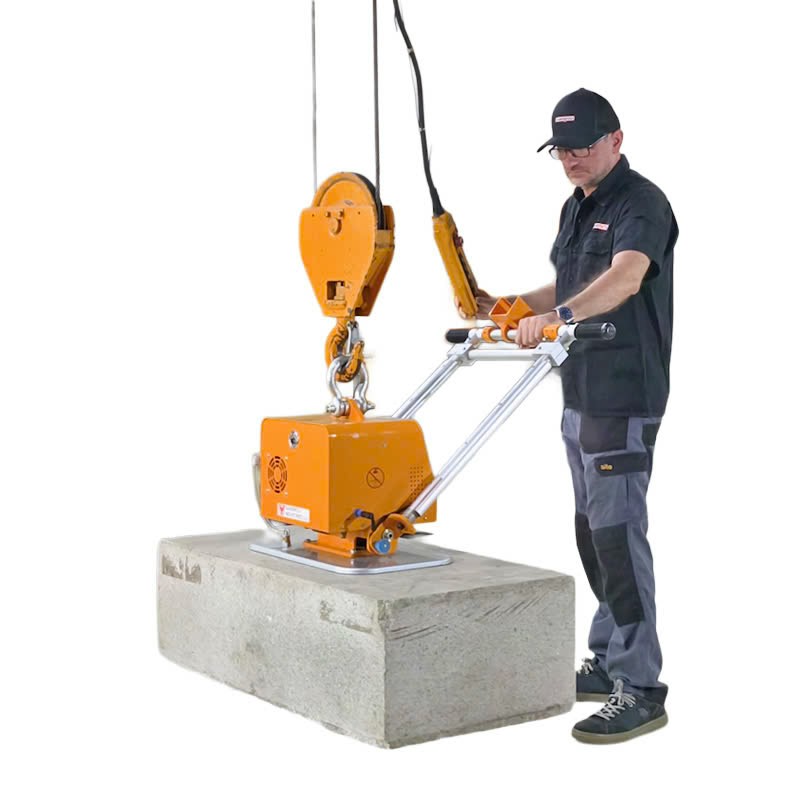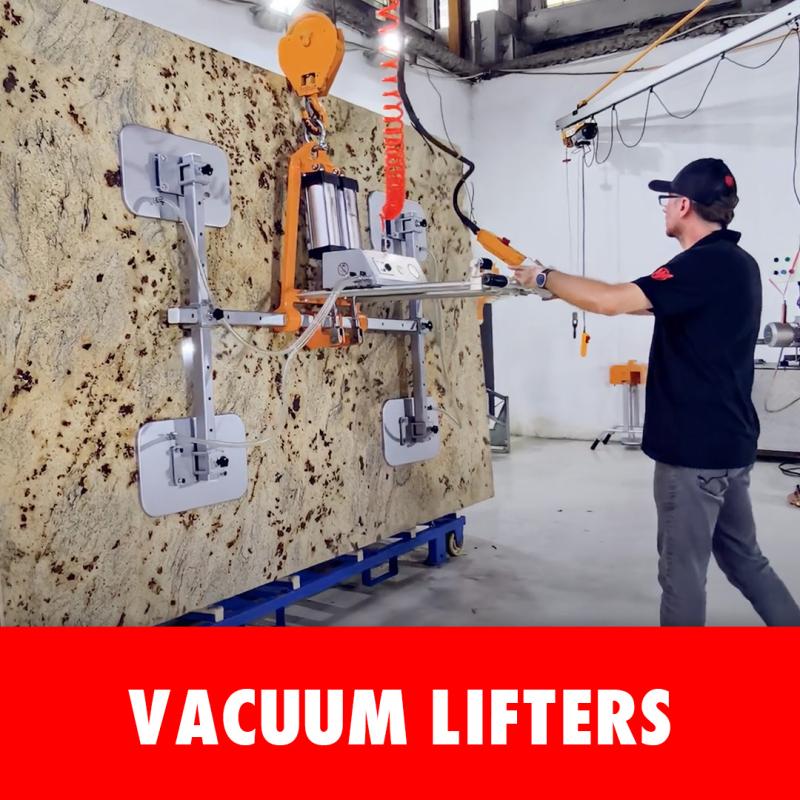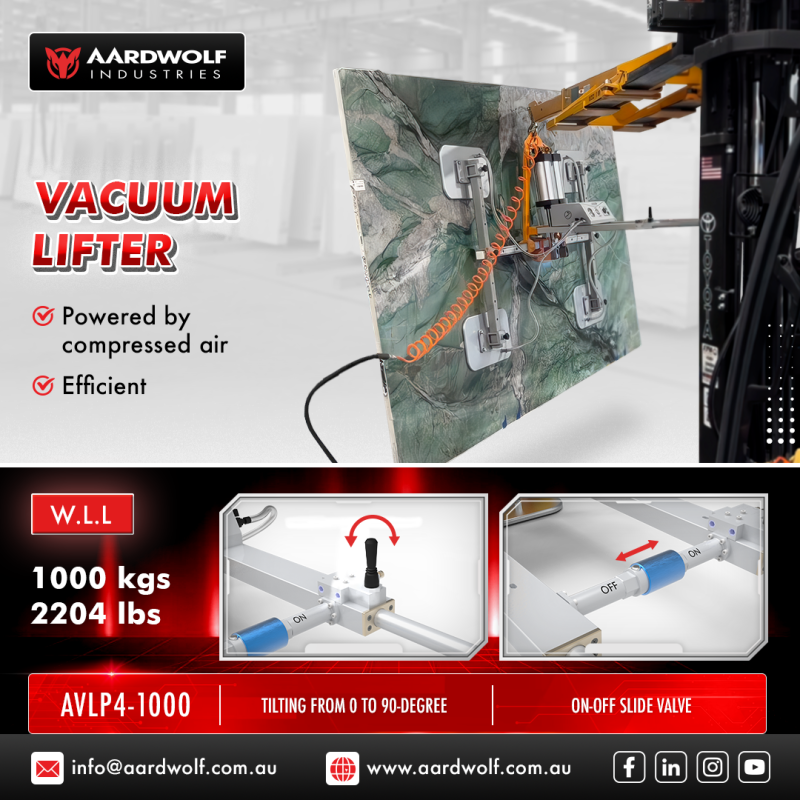



But how do a vacuum lifter work in practice? These machines create a vacuum seal between the lifting device and the object, allowing operators to handle large, flat, and heavy materials safely, efficiently, and ergonomically.
Vacuum lifters are commonly used in manufacturing, construction, logistics, and warehousing industries. They’re ideal for lifting non-porous or semi-porous materials such as glass, stone, metal sheets, wood panels, concrete blocks, and even food-grade products.
Vacuum lifters function by creating a negative pressure (vacuum) between a suction pad and the surface of an object. This pressure differential allows the suction pad to cling tightly to the object, enabling it to be lifted, transported, and precisely positioned.
Vacuum Pump: The vacuum pump is the heart of the system. It generates the vacuum needed to grip the object securely.
Suction Pads (End Effectors): These are in direct contact with the material being lifted. They must be the correct size and shape to form an airtight seal.
Control System: Allows the operator to manage suction, tilting, lifting, and releasing the load.
Lifting Mechanism: Often paired with cranes or forklifts, it performs the vertical or angular lifting motion.
The operator aligns the vacuum lifter above the object. The suction pad should cover enough surface area to create a reliable seal.
The pump is activated, drawing air out from between the pad and the surface, thus creating a vacuum. This causes atmospheric pressure to push the object against the pad, securing it tightly.
Once a firm seal is formed, the crane or hoist lifts the object vertically or tilts it for placement. Many models also offer 90° to 180° tilting and 360° rotation.
To release, the system allows air back into the suction pad, neutralizing the vacuum and detaching the object smoothly.

These models are powered by electric pumps and often used for precise and repetitive tasks. Ideal for indoor applications with consistent power supply needs.
Cordless and mobile, battery-operated lifters like the AVLP series by Aardwolf offer convenience, especially in construction or remote job sitesGeneral-Catalog-2025.
Often used in stone and glass industries, these systems are powered by compressed air and are preferred in environments where electricity is limited or hazardous.
Self-cycling systems powered by mechanical pumps, often with hand or foot controls. Ideal for lightweight applications or environments without electricity or compressed air.
Audio-Visual Alarms: Alert operators to low vacuum levels.
Vacuum Reservoir Tanks: Provide backup suction in case of pump failure.
Slide Valve Mechanisms: Simple controls for engaging and disengaging suction.
Modern vacuum lifters can:
Tilt materials from 0° to 90°
Rotate objects 360°
Handle loads from 40 kg to 2000 kg depending on the model
Lightweight aluminum frames
Adjustable handles
Shock-resistant suction pads
Weather-resistant materials for indoor and outdoor use
DC-powered and electric vacuum lifters like ARGL-500 are perfect for installing large glass sheets with safety and accuracyGeneral-Catalog-2025.
Heavy-duty models such as AVLP4 or APVL-1000 are built for rough stone slabs. These are frequently used in monument construction and architectural cladding.
Electric vacuum lifters with multiple pads like AEVLP8-2000 allow safe handling of large metal sheets in manufacturing plantsGeneral-Catalog-2025.
Lightweight lifters such as AVPL40 or APSL are used to lay paving stones efficiently while minimizing labor and injury risksGeneral-Catalog-2025.
FDA-grade vacuum lifters are available for hygienic material handling in food and pharmaceutical sectors.
Eliminates the need for manual lifting
Reduces risk of musculoskeletal injuries
Suitable for use in cleanroom and ATEX environments
Faster material transfer
Less operator fatigue
Lower operational downtime due to minimal maintenance
Handles different shapes, sizes, and weights
Compatible with forklifts, cranes, and jib arms
Customizable pad configurations
AVLP1 to AVLP4-P-1000
Lifting range: 125 kg to 1000 kg
Powered by 12V battery
Aluminum body and vacuum tank for safety
AVBL-380 and AVBL1000
Audio/visual alarms and large vacuum tanks
Ideal for concrete and construction use
Multi-pad systems with dual-circuit safety
Advanced tilting and rotating features for fragile glass panels
Electric-powered systems with working load limits up to 2000 kg
Perfect for large panels, sheet metal, and curtain walls
Daily Inspection: Check vacuum hoses, seals, and power supply.
Pad Cleaning: Wipe down suction pads to remove dust and debris.
Battery Charging: Fully recharge battery models after each use.
Scheduled Servicing: Periodic inspection of pumps and valves by certified technicians.
Understanding how do a vacuum lifter work reveals why they are essential tools in today’s industrial and construction environments. Whether you’re handling glass, stone, metal, or concrete, vacuum lifters reduce labor, enhance safety, and improve productivity. With advanced models available from leading brands like Aardwolf, there’s a vacuum lifting solution for virtually every application.
1. How to operate a Jib Crane safely
3. Over brace jib crane wall mounted
5. Is a Jib Crane a Gantry Crane
6. Articulated Jib Crane Wall Mounted
8. Manual Counterbalance Crane
10. Over Braced Jib Crane Column Mounted
Sign up to receive the latest info on new Aardwolf products, special offers and more.
By signing up you agree to receive emails from Aardwolf with news, special offers, promotions and other information. You can unsubscribe at any time.